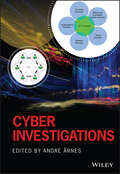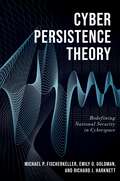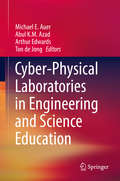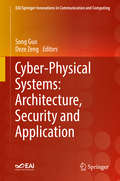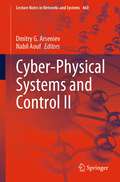- Table View
- List View
Cyber Forensics: Examining Emerging and Hybrid Technologies
by Albert J. MarcellaThreat actors, be they cyber criminals, terrorists, hacktivists or disgruntled employees, are employing sophisticated attack techniques and anti-forensics tools to cover their attacks and breach attempts. As emerging and hybrid technologies continue to influence daily business decisions, the proactive use of cyber forensics to better assess the risks that the exploitation of these technologies pose to enterprise-wide operations is rapidly becoming a strategic business objective. This book moves beyond the typical, technical approach to discussing cyber forensics processes and procedures. Instead, the authors examine how cyber forensics can be applied to identifying, collecting, and examining evidential data from emerging and hybrid technologies, while taking steps to proactively manage the influence and impact, as well as the policy and governance aspects of these technologies and their effect on business operations. A world-class team of cyber forensics researchers, investigators, practitioners and law enforcement professionals have come together to provide the reader with insights and recommendations into the proactive application of cyber forensic methodologies and procedures to both protect data and to identify digital evidence related to the misuse of these data. This book is an essential guide for both the technical and non-technical executive, manager, attorney, auditor, and general practitioner who is seeking an authoritative source on how cyber forensics may be applied to both evidential data collection and to proactively managing today’s and tomorrow’s emerging and hybrid technologies. The book will also serve as a primary or supplemental text in both under- and post-graduate academic programs addressing information, operational and emerging technologies, cyber forensics, networks, cloud computing and cybersecurity.
Cyber Forensics: A Field Manual for Collecting, Examining, and Preserving Evidence of Computer Crimes, Second Edition
by Albert Marcella Jr. Doug MenendezDesigned as an introduction and overview to the field, Cyber Forensics: A Field Manual for Collecting, Examining, and Preserving Evidence of Computer Crimes, Second Edition integrates theory and practice to present the policies, procedures, methodologies, and legal ramifications and implications of a cyber forensic investigation. The authors guide
Cyber Fraud: Tactics, Techniques and Procedures
by Rick HowardWith millions lost each year, cyber crime has evolved from a minor nuisance to a major concern involving well-organized actors and highly sophisticated organizations. Arguably one of the most important challenges of the 21st century, with millions lost each year, cyber crime has evolved from a minor nuisance to a major concern involving well-organized actors and highly sophisticated organizations. This volume explores the state of threats present in the cyber fraud underground. It discusses phishing/pharming, trojans/toolkits, direct threats, and pump-and-dump scams. By examining the operations of the cyber criminal, the book provides perspective into the general incentives, risks, and behavioral patterns of the fraudsters. Armed with this information, organizations and individuals are better able to develop countermeasures and crafting tactics to disrupt the fraud underground and secure their systems.
Cyber Influence and Cognitive Threats
by Vladlena Benson John McalaneyIn the wake of fresh allegations that personal data of Facebook users have been illegally used to influence the outcome of the US general election and the Brexit vote, the debate over manipulation of social Big Data continues to gain more momentum. Cyber Influence and Cognitive Threats addresses various emerging challenges in response to cybersecurity, examining cognitive applications in decision-making, behaviour and basic human interaction. The book examines the role of psychology in cybersecurity by addressing each factor involved in the process: hackers, targets, cybersecurity practitioners, and the wider social context in which these groups operate. Cyber Influence and Cognitive Threats covers a variety of topics including information systems, psychology, sociology, human resources, leadership, strategy, innovation, law, finance and others. Explains psychological factors inherent in machine learning and artificial intelligenceExplores attitudes towards data and privacy through the phenomena of digital hoarding and protection motivation theoryDiscusses the role of social and communal factors in cybersecurity behaviour and attitudesInvestigates the factors that determine the spread and impact of information and disinformation
Cyber Infrastructure for the Smart Electric Grid (IEEE Press)
by Anurag K. Srivastava Venkatesh Venkataramanan Carl HauserExplore a thorough treatment of the foundations of smart grid sensing, communication, computation, and control As electric power systems undergo a transformative upgrade with the integration of advanced technologies to enable the smarter electric grid, professionals who work in the area require a new understanding of the evolving complexity of the grid. Cyber Infrastructure for the Smart Electric Grid delivers a comprehensive overview of the fundamental principles of smart grid operation and control, smart grid technologies, including sensors, communication networks, computation, data management, and cyber security, and the interdependencies between the component technologies on which a smart grid’s security depends. The book offers readers the opportunity to critically analyze the smart grid infrastructure needed to sense, communicate, compute, and control in a secure way. Readers of the book will be able to apply the interdisciplinary principles they’ve learned in the book to design and build secure smart grid infrastructure. Readers will also benefit from the inclusion of: A thorough introduction to the key skills required by engineers to manage the evolving complexity of the electric grid An exploration of the interdependencies of smart grid infrastructure required to sense, communicate, compute, control, and manage data securely Software modules in .exe format for demonstrations and exercises An examination of the fundamental principles of smart grid operation and control Perfect for professionals working in the electric utility industries at electric utilities, vendors, and the national labs, Cyber Infrastructure for the Smart Electric Grid will also earn a place in the libraries of senior undergraduate and graduate students studying electrical engineering and smart grids.
Cyber Infrastructure for the Smart Electric Grid (IEEE Press)
by Anurag K. Srivastava Venkatesh Venkataramanan Carl HauserExplore a thorough treatment of the foundations of smart grid sensing, communication, computation, and control As electric power systems undergo a transformative upgrade with the integration of advanced technologies to enable the smarter electric grid, professionals who work in the area require a new understanding of the evolving complexity of the grid. Cyber Infrastructure for the Smart Electric Grid delivers a comprehensive overview of the fundamental principles of smart grid operation and control, smart grid technologies, including sensors, communication networks, computation, data management, and cyber security, and the interdependencies between the component technologies on which a smart grid’s security depends. The book offers readers the opportunity to critically analyze the smart grid infrastructure needed to sense, communicate, compute, and control in a secure way. Readers of the book will be able to apply the interdisciplinary principles they’ve learned in the book to design and build secure smart grid infrastructure. Readers will also benefit from the inclusion of: A thorough introduction to the key skills required by engineers to manage the evolving complexity of the electric grid An exploration of the interdependencies of smart grid infrastructure required to sense, communicate, compute, control, and manage data securely Software modules in .exe format for demonstrations and exercises An examination of the fundamental principles of smart grid operation and control Perfect for professionals working in the electric utility industries at electric utilities, vendors, and the national labs, Cyber Infrastructure for the Smart Electric Grid will also earn a place in the libraries of senior undergraduate and graduate students studying electrical engineering and smart grids.
Cyber Investigations
by André ÅrnesCYBER INVESTIGATIONS A classroom tested introduction to cyber investigations with real-life examples included Cyber Investigations provides an introduction to the topic, an overview of the investigation process applied to cyber investigations, a review of legal aspects of cyber investigations, a review of Internet forensics and open-source intelligence, a research-based chapter on anonymization, and a deep-dive in to multimedia forensics. The content is structured in a consistent manner, with an emphasis on accessibility for students of computer science, information security, law enforcement, and military disciplines. To aid in reader comprehension and seamless assimilation of the material, real-life examples and student exercises are provided throughout, as well as an Educational Guide for both teachers and students. The material has been classroom-tested and is a perfect fit for most learning environments. Written by a highly experienced author team with backgrounds in law enforcement, academic research, and industry, sample topics covered in Cyber Investigations include: The cyber investigation process, including developing an integrated framework for cyber investigations and principles for the integrated cyber investigation process (ICIP) Cyber investigation law, including reasonable grounds to open a criminal cyber investigation and general conditions for privacy-invasive cyber investigation methods Perspectives of internet and cryptocurrency investigations, including examples like the proxy seller, the scammer, and the disgruntled employee Internet of things (IoT) investigations, including types of events leading to IoT investigations and new forensic challenges in the field Multimedia forensics facilitates the understanding of the role of multimedia in investigations, including how to leverage similarity matching, content-based tracing, and media metadata. Anonymization networks discusses how such networks work, and how they impact investigations? It addresses aspects of tracing, monitoring, evidence acquisition, de-anonymization, and large investigations Based on research, teaching material, experiences, and student feedback over several years, Cyber Investigations is ideal for all students and professionals in the cybersecurity industry, providing comprehensive subject coverage from faculty, associates, and former students of cyber security and digital forensics at the Norwegian University of Science and Technology (NTNU).
Cyber Investigations
by André ÅrnesCYBER INVESTIGATIONS A classroom tested introduction to cyber investigations with real-life examples included Cyber Investigations provides an introduction to the topic, an overview of the investigation process applied to cyber investigations, a review of legal aspects of cyber investigations, a review of Internet forensics and open-source intelligence, a research-based chapter on anonymization, and a deep-dive in to multimedia forensics. The content is structured in a consistent manner, with an emphasis on accessibility for students of computer science, information security, law enforcement, and military disciplines. To aid in reader comprehension and seamless assimilation of the material, real-life examples and student exercises are provided throughout, as well as an Educational Guide for both teachers and students. The material has been classroom-tested and is a perfect fit for most learning environments. Written by a highly experienced author team with backgrounds in law enforcement, academic research, and industry, sample topics covered in Cyber Investigations include: The cyber investigation process, including developing an integrated framework for cyber investigations and principles for the integrated cyber investigation process (ICIP) Cyber investigation law, including reasonable grounds to open a criminal cyber investigation and general conditions for privacy-invasive cyber investigation methods Perspectives of internet and cryptocurrency investigations, including examples like the proxy seller, the scammer, and the disgruntled employee Internet of things (IoT) investigations, including types of events leading to IoT investigations and new forensic challenges in the field Multimedia forensics facilitates the understanding of the role of multimedia in investigations, including how to leverage similarity matching, content-based tracing, and media metadata. Anonymization networks discusses how such networks work, and how they impact investigations? It addresses aspects of tracing, monitoring, evidence acquisition, de-anonymization, and large investigations Based on research, teaching material, experiences, and student feedback over several years, Cyber Investigations is ideal for all students and professionals in the cybersecurity industry, providing comprehensive subject coverage from faculty, associates, and former students of cyber security and digital forensics at the Norwegian University of Science and Technology (NTNU).
Cyber Law and Ethics: Regulation of the Connected World
by Mark Grabowski Eric P. RobinsonA primer on legal issues relating to cyberspace, this textbook introduces business, policy and ethical considerations raised by our use of information technology. With a focus on the most significant issues impacting internet users and businesses in the United States of America, the book provides coverage of key topics such as social media, online privacy, artificial intelligence and cybercrime as well as emerging themes such as doxing, ransomware, revenge porn, data-mining, e-sports and fake news. The authors, experienced in journalism, technology and legal practice, provide readers with expert insights into the nuts and bolts of cyber law. Cyber Law and Ethics: Regulation of the Connected World provides a practical presentation of legal principles, and is essential reading for non-specialist students dealing with the intersection of the internet and the law.
Cyber Law and Ethics: Regulation of the Connected World
by Mark Grabowski Eric P. RobinsonA primer on legal issues relating to cyberspace, this textbook introduces business, policy and ethical considerations raised by our use of information technology. With a focus on the most significant issues impacting internet users and businesses in the United States of America, the book provides coverage of key topics such as social media, online privacy, artificial intelligence and cybercrime as well as emerging themes such as doxing, ransomware, revenge porn, data-mining, e-sports and fake news. The authors, experienced in journalism, technology and legal practice, provide readers with expert insights into the nuts and bolts of cyber law. Cyber Law and Ethics: Regulation of the Connected World provides a practical presentation of legal principles, and is essential reading for non-specialist students dealing with the intersection of the internet and the law.
Cyber Litigation: The Legal Principles
by Dean Armstrong QC Fergus McCombie Ceri DavisWritten by a team of experts from 36 Commercial, this new title describes the developing substance of cyber litigation setting out the position as regards: - disputes where the subject matter is data or a database- where the subject matter is software/programming and connected IP issues- regulatory implications and e-contracts- currency- internet of thingsIt looks at the most common causes of action in cyber litigation, including cybercrime, IP (breach of copyright, trade mark infringement etc.), data protection breaches (eg DPA, GDPR); conflict of laws considerations; alternatives to litigation, such as, the NCA Prevent scheme and situations where arbitration/mediation are mandated. It identifies the pitfalls that those working in this arena need to look out for and address in order not to become involved in litigation as well as advice for those who do find themselves involved in cyber litigation.
Cyber Persistence Theory: Redefining National Security in Cyberspace (Bridging the Gap)
by Michael P. Fischerkeller Emily O. Goldman Richard J. HarknettA bold re-conceptualization of the fundamentals driving behavior and dynamics in cyberspace. Most cyber operations and campaigns fall short of activities that states would regard as armed conflict. In Cyber Persistence Theory, Michael P. Fischerkeller, Emily O. Goldman, and Richard J. Harknett argue that a failure to understand this strategic competitive space has led many states to misapply the logic and strategies of coercion and conflict to this environment and, thus, suffer strategic loss as a result. The authors show how the paradigm of deterrence theory can neither explain nor manage the preponderance of state cyber activity. They present a new theory that illuminates the exploitive, rather than coercive, dynamics of cyber competition and an analytical framework that can serve as the basis for new strategies of persistence. Drawing on their policy experience, they offer a new set of prescriptions to guide policymakers toward a more stable, secure cyberspace.
Cyber Persistence Theory: Redefining National Security in Cyberspace (Bridging the Gap)
by Emily O. Goldman Michael P. Fischerkeller Richard J. HarknettA bold re-conceptualization of the fundamentals driving behavior and dynamics in cyberspace. Most cyber operations and campaigns fall short of activities that states would regard as armed conflict. In Cyber Persistence Theory, Michael P. Fischerkeller, Emily O. Goldman, and Richard J. Harknett argue that a failure to understand this strategic competitive space has led many states to misapply the logic and strategies of coercion and conflict to this environment and, thus, suffer strategic loss as a result. The authors show how the paradigm of deterrence theory can neither explain nor manage the preponderance of state cyber activity. They present a new theory that illuminates the exploitive, rather than coercive, dynamics of cyber competition and an analytical framework that can serve as the basis for new strategies of persistence. Drawing on their policy experience, they offer a new set of prescriptions to guide policymakers toward a more stable, secure cyberspace.
Cyber-Physical Laboratories in Engineering and Science Education
by Michael E. Auer Abul K.M. Azad Arthur Edwards Ton De JongThis volume investigates a number of issues needed to develop a modular, effective, versatile, cost effective, pedagogically-embedded, user-friendly, and sustainable online laboratory system that can deliver its true potential in the national and global arenas. This allows individual researchers to develop their own modular systems with a level of creativity and innovation while at the same time ensuring continuing growth by separating the responsibility for creating online laboratories from the responsibility for overseeing the students who use them. The volume first introduces the reader to several system architectures that have proven successful in many online laboratory settings. The following chapters then describe real-life experiences in the area of online laboratories from both technological and educational points of view. The volume further collects experiences and evidence on the effective use of online labs in the context of a diversity of pedagogical issues. It also illustrates successful online laboratories to highlight best practices as case studies and describes the technological design strategies, implementation details, and classroom activities as well as learning from these developments. Finally the volume describes the creation and deployment of commercial products, tools and services for online laboratory development. It also provides an idea about the developments that are on the horizon to support this area.
Cyber-Physical Systems: Architecture, Security and Application (EAI/Springer Innovations in Communication and Computing)
by Song Guo Deze ZengThis book provides an overview of recent innovations and achievements in the broad areas of cyber-physical systems (CPS), including architecture, networking, systems, applications, security, and privacy. The book discusses various new CPS technologies from diverse aspects to enable higher level of innovation towards intelligent life. The book provides insight to the future integration, coordination and interaction between the physical world, the information world, and human beings. The book features contributions from renowned researchers and engineers, who discuss key issues from various perspectives, presenting opinions and recent CPS-related achievements.Investigates how to advance the development of cyber-physical systems Provides a joint consideration of other newly emerged technologies and concepts in relation to CPS like cloud computing, big data, fog computing, and crowd sourcingIncludes topics related to CPS such as architecture, system, networking, application, algorithm, security and privacy
Cyber-Physical Systems: Solutions to Pandemic Challenges
by Tushar SemwalA Cyber-Physical System (CPS) is an integration of cyber components with their physical counterparts. A cyber unit could be either a software or hardware. Physical components are those objects, which are governed by the law of physics. CPS have transformed how we interact with the physical world, ranging from sensing the environmental parameters to controlling a complex manufacturing industry. The current pandemic has had catastrophic implications people all across the world in terms of health and economy. This book presents the significance and practicality of CPS in a pandemic situation. It provides a strong foundation to the CPS while also incorporating the latest theoretical advances and practical applications to alleviate the state of a pandemic. The book covers… Theoretical background and application-oriented overview of the different CPS models Impact of COVID-19 and similar pandemics on the engineering aspects of various industries and organisations Exciting and impactful CPS based solutions to the different pandemic situations Security and privacy in CPS when applied to critical and sensitive pandemic affected environment Describes the government-funded projects and work using CPS in real-world scenarios The book provides a unique and fresh exposure to CPS employed in a pandemic situation. It brings together researchers, practitioners, academics, experts, and industry professionals from around the world to share their knowledge and experience.
Cyber-Physical Systems: Solutions to Pandemic Challenges
by Tushar Semwal Faiz IqbalA Cyber-Physical System (CPS) is an integration of cyber components with their physical counterparts. A cyber unit could be either a software or hardware. Physical components are those objects, which are governed by the law of physics. CPS have transformed how we interact with the physical world, ranging from sensing the environmental parameters to controlling a complex manufacturing industry. The current pandemic has had catastrophic implications people all across the world in terms of health and economy. This book presents the significance and practicality of CPS in a pandemic situation. It provides a strong foundation to the CPS while also incorporating the latest theoretical advances and practical applications to alleviate the state of a pandemic. The book covers… Theoretical background and application-oriented overview of the different CPS models Impact of COVID-19 and similar pandemics on the engineering aspects of various industries and organisations Exciting and impactful CPS based solutions to the different pandemic situations Security and privacy in CPS when applied to critical and sensitive pandemic affected environment Describes the government-funded projects and work using CPS in real-world scenarios The book provides a unique and fresh exposure to CPS employed in a pandemic situation. It brings together researchers, practitioners, academics, experts, and industry professionals from around the world to share their knowledge and experience.
Cyber-Physical Systems and Control (Lecture Notes in Networks and Systems #95)
by Dmitry G. Arseniev Ludger Overmeyer Heikki Kälviäinen Branko KatalinićThis book presents the proceedings of the International Conference on Cyber-Physical Systems and Control (CPS&C'2019), held in Peter the Great St. Petersburg Polytechnic University, which is celebrating its 120th anniversary in 2019. The CPS&C'2019 was dedicated to the 35th anniversary of the partnership between Peter the Great St. Petersburg Polytechnic University and Leibniz University of Hannover. Cyber-physical systems (CPSs) are a new generation of control systems and techniques that help promote prospective interdisciplinary research. A wide range of theories and methodologies are currently being investigated and developed in this area to tackle various complex and challenging problems. Accordingly, CPSs represent a scientific and engineering discipline that is set to make an impact on future systems of industrial and social scale that are characterized by the deep integration of real-time processing, sensing, and actuation into logical and physical heterogeneous domains. The CPS&C'2019 brought together researchers and practitioners from all over the world and to discuss cross-cutting fundamental scientific and engineering principles that underline the integration of cyber and physical elements across all application fields. The participants represented research institutions and universities from Austria, Belgium, Bulgaria, China, Finland, Germany, the Netherlands, Russia, Syria, Ukraine, the USA, and Vietnam. These proceedings include 75 papers arranged into five sections, namely keynote papers, fundamentals, applications, technologies, and education and social aspects.
Cyber-Physical Systems and Control II (Lecture Notes in Networks and Systems #460)
by Dmitry G. Arseniev Nabil AoufThe book contains selected research papers presented at the 2nd International Conference on Cyber-Physical Systems and Control (CPS&C’2021) which was held from 29 June to 2 July 2021 in St. Petersburg, Russia. The CPS&C’2021 Conference continues the series of international conferences that began in 2019 when the first International Conference on Cyber-Physical Systems and Control (CPS&C’2019) took place. Cyber-physical systems (CPSs) considered a modern and rapidly emerging generation of systems with integrated wide computational, information processing, and physical capabilities that can interact with humans through many new modalities and application areas of implementation. The book covers the latest advances, developments and achievements in new theories, algorithms, models, and applications of prospective problems associated with CPSs with an emphasis on control theory and related areas. The multidisciplinary fundamental scientific and engineering principles that underpin the integration of cyber and physical elements across all application areas are discussed in the book chapters. The materials of the book may be of interest to scientists and engineers working in the field of cyber-physical systems, systems analysis, control systems, computer technologies, and similar fields.
Cyber-Physical Systems and Industry 4.0: Practical Applications and Security Management
by Dinesh GoyalThis new work explores the growth of information and communication technologies with an emphasis on cyber-physical systems and security management of these systems. This volume discusses and analyzes the various effective practical applications of CPS, which involves the integration of the physical process with embedded computation and network monitoring along with feedback loops from physical systems. The authors identify the best set of applications and discuss the drawbacks of existing systems. The book provides a broad outlook on the applications of cyber-physical systems along with case studies and examples in healthcare, automotive electronics, industrial automation, environment monitoring, agriculture, and applications in civil and mechanical sectors. Topics include using an energy management system in smart grids, implementing an intelligent traffic management system, warehouse tracking and monitoring, medical cyber-physical systems security, remote healthcare monitoring, and more.
Cyber-Physical Systems and Industry 4.0: Practical Applications and Security Management
by Dinesh Goyal Shanmugam Balamurugan Karthikrajan Senthilnathan Iyswarya Annapoorani Mohammad IsrarThis new work explores the growth of information and communication technologies with an emphasis on cyber-physical systems and security management of these systems. This volume discusses and analyzes the various effective practical applications of CPS, which involves the integration of the physical process with embedded computation and network monitoring along with feedback loops from physical systems. The authors identify the best set of applications and discuss the drawbacks of existing systems. The book provides a broad outlook on the applications of cyber-physical systems along with case studies and examples in healthcare, automotive electronics, industrial automation, environment monitoring, agriculture, and applications in civil and mechanical sectors. Topics include using an energy management system in smart grids, implementing an intelligent traffic management system, warehouse tracking and monitoring, medical cyber-physical systems security, remote healthcare monitoring, and more.
Cyber-Physical Systems in the Construction Sector
by Wesam Salah AlaloulCyber-Physical Systems (CPSs) are mechanisms for monitoring and controlling processes using computer-based algorithms. In the construction industry, CPSs help to increase the viability of construction projects by reducing costs, time and management effort. This book aims to develop the fundamental concepts of construction project management associated with the CPSs and their applications within the modern construction industry in alignment with the scope of the Fourth Industrial Revolution (IR4.0). The book has been structured in a systematic way for easy understanding by construction industry researchers and academic faculty. The first part of the book helps readers to develop a basic understanding of the fundamental concepts of construction project management and CPSs. Followed by the second part about the CPSs implementation framework and understanding the operational concepts associated with the notion of IoT and Digital Twins within the construction industry. The third part of the book describes modelling/simulation techniques to develop the customised CPSs for construction project management. The concluding part provides an in-depth review of applications of CPSs, associated threats and security.
Cyber-Physical Systems in the Construction Sector
by Wesam Salah AlaloulCyber-Physical Systems (CPSs) are mechanisms for monitoring and controlling processes using computer-based algorithms. In the construction industry, CPSs help to increase the viability of construction projects by reducing costs, time and management effort. This book aims to develop the fundamental concepts of construction project management associated with the CPSs and their applications within the modern construction industry in alignment with the scope of the Fourth Industrial Revolution (IR4.0). The book has been structured in a systematic way for easy understanding by construction industry researchers and academic faculty. The first part of the book helps readers to develop a basic understanding of the fundamental concepts of construction project management and CPSs. Followed by the second part about the CPSs implementation framework and understanding the operational concepts associated with the notion of IoT and Digital Twins within the construction industry. The third part of the book describes modelling/simulation techniques to develop the customised CPSs for construction project management. The concluding part provides an in-depth review of applications of CPSs, associated threats and security.
Cyber-physische Produktionssysteme für die energieeffiziente Komponentenproduktion (AutoUni – Schriftenreihe #152)
by Ingo LabbusDie vorliegende Dissertation präsentiert ein Konzept für den Einsatz cyber-physischer Produktionssysteme zur Steigerung der Energieeffizienz in der Komponentenproduktion. Das entwickelte Konzept integriert dafür Ansätze zu Datenmodellierung, -aufbereitung, und -analyse sowie Werkzeuge zur Planung energieeffizienter Produktionen. Dieses ermöglicht die Herstellung der Datendurchgängigkeit zwischen Planung und Betrieb der Produktion, erhöht die Transparenz über aktuelle Energiebedarfe sowie Einsparpotenziale und erleichtert so die Planung energieeffizienter Produktionen. Die Entwicklung und Anwendung des Konzeptes erfolgt am Beispiel der Fertigung von Komponenten für die Automobilproduktion.
Cyber Resilience
by Sergei PetrenkoModern cyber systems acquire more emergent system properties, as far as their complexity increases: cyber resilience, controllability, self-organization, proactive cyber security and adaptability. Each of the listed properties is the subject of the cybernetics research and each subsequent feature makes sense only if there is a previous one.Cyber resilience is the most important feature of any cyber system, especially during the transition to the sixth technological stage and related Industry 4.0 technologies: Artificial Intelligence (AI), Cloud and foggy computing, 5G +, IoT/IIoT, Big Data and ETL, Q-computing, Blockchain, VR/AR, etc. We should even consider the cyber resilience as a primary one, because the mentioned systems cannot exist without it. Indeed, without the sustainable formation made of the interconnected components of the critical information infrastructure, it does not make sense to discuss the existence of 4.0 Industry cyber-systems. In case when the cyber security of these systems is mainly focused on the assessment of the incidents' probability and prevention of possible security threats, the cyber resilience is mainly aimed at preserving the targeted behavior and cyber systems' performance under the conditions of known (about 45 %) as well as unknown (the remaining 55 %) cyber attacks.This monograph shows that modern Industry 4.0. Cyber systems do not have the required cyber resilience for targeted performance under heterogeneous mass intruder cyber-attacks. The main reasons include a high cyber system structural and functional complexity, a potential danger of existing vulnerabilities and “sleep” hardware and software tabs, as well as an inadequate efficiency of modern models, methods, and tools to ensure cyber security, reliability, response and recovery.





